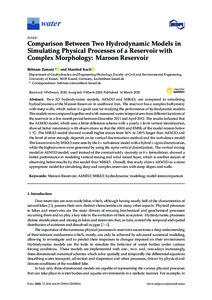Comparison Between Two Hydrodynamic Models in Simulating Physical Processes of a Reservoir with Complex Morphology: Maroon Reservoir
| dc.date.accessioned | 2020-05-22T09:32:20Z | |
| dc.date.available | 2020-05-22T09:32:20Z | |
| dc.date.issued | 2020-03-14 | |
| dc.identifier | doi:10.17170/kobra-202005201280 | |
| dc.identifier.uri | http://hdl.handle.net/123456789/11567 | |
| dc.description.sponsorship | Gefördert durch den Publikationsfonds der Universität Kassel | |
| dc.language.iso | eng | |
| dc.rights | Namensnennung 4.0 International | * |
| dc.rights.uri | http://creativecommons.org/licenses/by/4.0/ | * |
| dc.subject | Maroon Reservoir | eng |
| dc.subject | AEM3D | eng |
| dc.subject | MIKE3 | eng |
| dc.subject | hydrodynamic modeling | eng |
| dc.subject | model intercomparison | eng |
| dc.subject.ddc | 550 | |
| dc.subject.ddc | 620 | |
| dc.title | Comparison Between Two Hydrodynamic Models in Simulating Physical Processes of a Reservoir with Complex Morphology: Maroon Reservoir | eng |
| dc.type | Aufsatz | |
| dcterms.abstract | Two 3D hydrodynamic models, AEM3D and MIKE3, are compared in simulating hydrodynamics of the Maroon Reservoir in southwest Iran. The reservoir has a complex bathymetry with steep walls, which makes it a good case for studying the performance of hydrodynamic models. The models were compared together and with measured water temperatures from different locations of the reservoir in a five-month period between December 2011 and April 2012. The results indicated that the AEM3D model, which uses a finite difference scheme with a purely z-level vertical discretization, showed better consistency with observations so that the AME and RMSE of the model remain below 1 °C. The MIKE3 model showed overall higher errors from 56% to 130% larger than AEM3D and the level of error strongly depends on its vertical discretization method and the turbulence model. The lowest errors by MIKE3 were seen by the k-ε turbulence model with a hybrid z-sigma discretization, while the highest errors were generated by using the sigma vertical discretization. The vertical mixing model in AEM3D model, used instead of the constant eddy viscosity or k-ε formulation, showed a better performance in modeling vertical mixing and wind mixed layer, which is another reason of observing better results by this model than MIKE3. Overall, this study shows AEM3D as a more appropriate model for simulating deep and complex reservoirs with steep slopes and walls. | eng |
| dcterms.accessRights | open access | |
| dcterms.creator | Zamani, Behnam | |
| dcterms.creator | Koch, Manfred | |
| dc.relation.doi | doi:10.3390/w12030814 | |
| dc.subject.swd | Hydrodynamik | ger |
| dc.subject.swd | Hydrodynamisches Modell | ger |
| dc.subject.swd | Hydrologie | ger |
| dc.type.version | publishedVersion | |
| dcterms.source.identifier | EISSN 2073-4441 | |
| dcterms.source.issue | Issue 3 | |
| dcterms.source.journal | Water | eng |
| dcterms.source.pageinfo | 814 | |
| dcterms.source.volume | Volume 12 | |
| kup.iskup | false |
Dateien zu dieser Ressource
Das Dokument erscheint in:
-
Artikel [1103]


